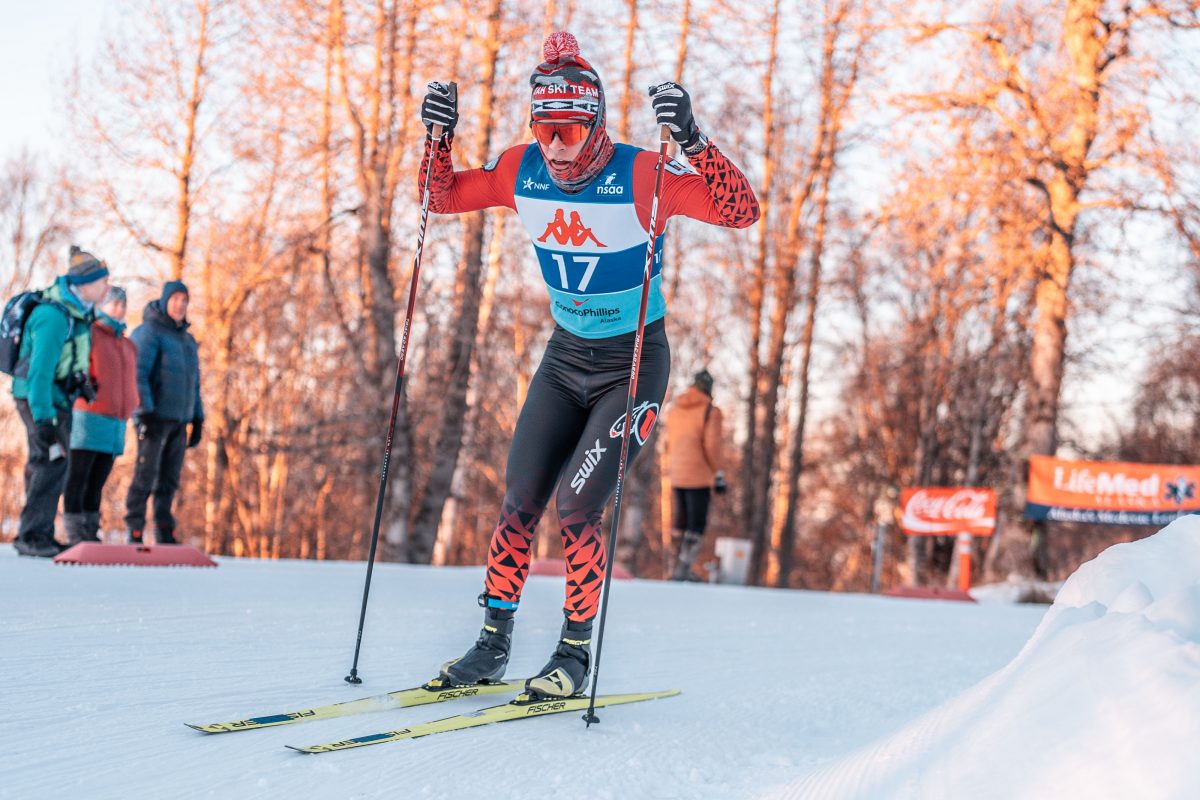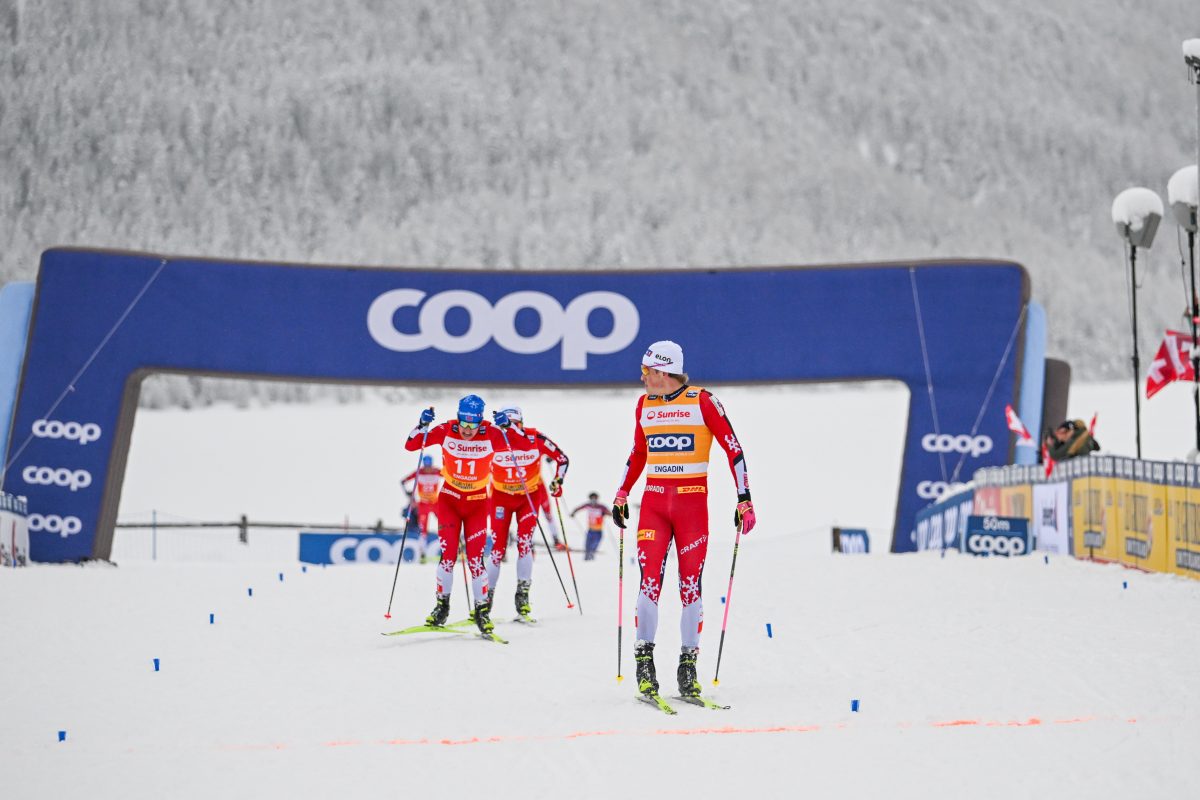
ANCHORAGE, Alaska — Gus Schumacher spent last winter traveling the world for ski racing, including laying down the season’s most dramatic anchor leg, non-Jessie Diggins edition, to bring the U.S. men’s relay team from fourth to a historic second at World Juniors. The then-high school senior also spent the season touring the country to plan his future in ski racing, talking with multiple NCAA coaches to discuss their programs and weigh everything from coaching philosophy to snow conditions and altitude. In the end, Schumacher chose to return back home to where it all began, Jan Buron and Alaska Winter Stars, where he prepares for what’s next from the comfort of his childhood home.
Schumacher, 18, spoke with FasterSkier in late December, shortly before leaving for U.S. Nationals in Vermont. We discussed his goals for this year’s World Juniors relay, the appeal of the familiar, and the future of American men’s skiing, among other areas.
The early years
Schumacher was born Outside, in Madison, Wisconsin, while his father was finishing a medical residency. Weeks later, he moved to Alaska for good. He had a classic Anchorage kid introduction to skiing: strap-on skis in the backyard, graduating to Anchorage Junior Nordic League a few years later.
“I started at Kincaid Junior Nordic,” Schumacher reminisced, “all the way through my first years as a Hawk, and then did Hillside Junior Nordic for my last couple years as a Hawk. I’ve still got the pictures of my first night home as a Hawk, with the new jacket, and holding up the skis. It was a pretty memorable event.”
(There are four levels in the Junior Nordic program – Polar Cub, Otter, Wolverine, and Hawk – with Hawks as the most advanced group, as marked by a distinctive jacket. Other famous quondam Hawks include Kikkan Randall, Tyler Kornfield, and pretty much anyone else who grew up skiing in Anchorage in the past 30 years.)
Schumacher didn’t dabble in too many other sports outside of skiing, but he was an avid soccer player. The family – siblings Heidi (now 12) and Rudy (now 15), and their parents, who work as an orthopedic surgeon (father Greg, who has worked with the U.S. Ski Team) and a pediatrician (mom Amy) – spent some summers in Kenai, for cabin time and fishing, and Gus and Rudy played in a soccer league there.
There was no single Saul on the road to Damascus moment when Schumacher knew he wanted to be a skier, he now recalls, so much as a more organic progression.
“It was more just, I stuck with it,” Schumacher says. “I remember, like, as a Junior Nordic skier, seeing Winter Stars skiing around, and wanting to be like that. And then seeking Kikkan have success, and wanting to be like that. Just kind of always having skiers as my main role models. It wasn’t like a big event, I’d say.”

(And as for those role models, this is as good a place as any to mention Kikkan’s thoughts on a then-13-year-old Schumacher racing at Spring Series 2014: “We spent all winter on the World Cup and you almost forget what it was like when you were first getting going in skiing and how these local races were so big. We could have some future Olympians out here – kids that you want, people that you want to get fired up about cross-country skiing.”)
By the time Schumacher was nine or ten, he had joined the Alaska Winter Stars program long run by Jan Buron. He offers up another photographic memory to place the date that he joined: “It was third or fourth grade. Because I remember there was a year where we were allowed to bring props in for our school pictures, and I brought skis and wore my Winter Stars jacket that was new, and that I was pretty proud of.”
Alaska Winter Stars, then and now
Fast forward nine years, and Schumacher remains happily ensconced within the Alaska Winter Stars (AWS) family.
There has historically not been a strong post-juniors program at AWS, which has led many Winter Stars athletes to move to other programs, either in Alaska or the lower 48, soon after they finish high school. Tyler Kornfield and Scott Patterson are two recent examples of athletes who raced for AWS through high school, then did some NCAA racing, then moved to the APU Elite Team.
In contrast to these examples, Schumacher ultimately decided to stay with Buron and Alaska Winter Stars after he graduated from high school in May 2018. The decision is readily explained by the existence of an ongoing athlete–coach relationship stretching back nearly a decade and yielding multiple strong results; in addition to that World Juniors silver, Schumacher is also a two-time Alaska state high school ski champion. But it was very much a reasoned decision, following a lengthy and considered process.
“It was definitely one of the harder decisions I’ve made,” Schumacher says of the decision to forego the APU Elite Team in Anchorage, NCAA skiing anywhere in the country, or any other option to remain with his longtime coach and program.
So how did he go about it?
“My thought process was, I started with five or six [NCAA] schools,” Schumacher now reconstructs.
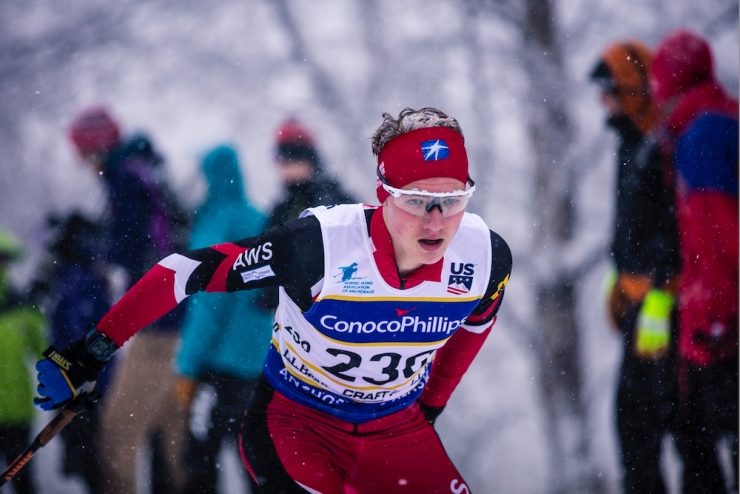
“I started by emailing a bunch of coaches, and made some phone calls, and I talked with people I knew who had gone to places, and I toured a few places. And I asked some of the same questions at every place, like, ‘How’s the snow,’ ‘How’s the altitude,’ ‘What is your general philosophy on training and strength,’ ‘How’s the race schedule,’ ‘How’s the team,’ ‘How do you view growth, and growth outside of NCAA,’ and so on.”
“And it kind of came down to, who’s a coach that I know about? And I know that taking that risk [of moving to a different coach] is obviously something that works out really well for a lot of people with a new coach, but I ultimately thought I knew what was going on here, and I knew that I could keep getting better here [with Buron]. And that the snow, while it’s not the best here, it’s pretty consistent, and I can do whatever competitions I want basically and I don’t have to be distracted by a full-time classload. So that’s kind of how I came to that. But I think there’s a number of ways it could have gone, and I think a number of ways that it probably could have gone pretty well, but for now I’m happy with where I’m at. I think I made the right decision.”
So far, the decision seems to have worked out well for Schumacher. (This was perhaps more of an open question at the time of the original interview for this story, before Schumacher consistently destroyed the junior field at 2019 Senior Nationals, placing 4th, 5th, 7th, and 12th overall in four races while recording the highest junior finish in each event.)
“I think it has,” Schumacher muses.
He adds, in a self-effacing nod to his millennial status, “There’s been some times where I felt like lots of people moved on, and I didn’t move on, and sometimes that makes me feel like, I guess, the classic millennial, where I’m still at home, and what am I doing… but I just need to think about why I’m staying, and that my training’s going well, and my collaboration with my coach is going well, and I’ve still got people like Luke [Jager], and athletes who haven’t gone off to college and who are doing a similar thing as me, and kind of going for the same goals, and it’s good to have them around.”
So who is still around? Or put another way, and perhaps more bluntly, does one of the country’s top juniors even have a training group?
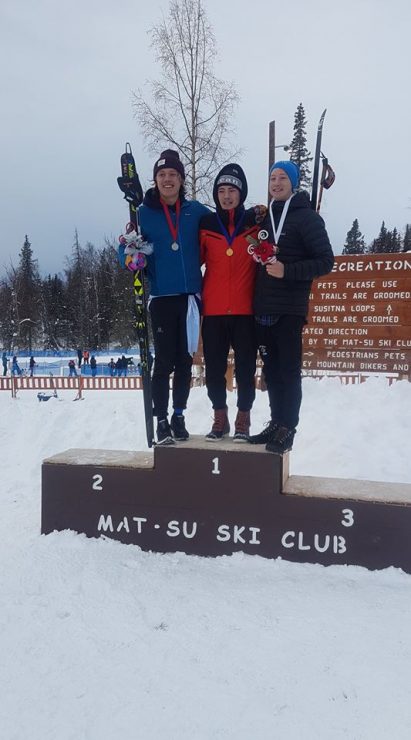
“I for sure do,” Schumacher reassures. “I spend a good amount of time alone, just based on convenience; it’s easier sometimes to just go out alone. But I train with Marion [Woods] sometimes, as the ‘Winter Stars Elite Team,’ just joking, in quotes. But I train with Luke, and Dawson [Knopp], and Tracen [Knopp], and lots of those younger APU guys I can train with, and some of those UAA [University of Alaska Anchorage] guys. Once in a while I’ll do some intervals, and we do distance sessions together a lot.”
The flip side of a training group of one may be that Schumacher has a training plan for one. His training plan is “definitely based” on Buron’s guidance, Schumacher says, “but more recently, when it’s mostly just me, and I’m not really training with a lot of other people, he’ll call me at night, and we kind of talk about what to do the next day.”
Schumacher is, like many experienced athletes and coaches, making the move toward becoming more of his own coach. “I think I’ve been doing a better job of trying to have my own input,” Schumacher reasons, “and making sure I’m not just following what he does, but really trying to get an understanding for why he’s saying what he’s saying, and then get an understanding from other coaches who say why to do stuff.”
Schumacher will think through this, then advise, for example, “’Maybe we should do a little heavier on the L4 today,’ or something like that. Sometimes he’ll say, ‘Yeah, that could be a good idea,’ and sometimes he thinks I’m wrong. We’ve started to argue a little more, as I’ve gotten older, which sometimes is probably a little annoying to him, but I think is pretty helpful, for me at least, to try to get a better understanding of training, so I’m not always asking him every day what I need to do. … Jan hasn’t been, like, ‘You need to do this.’ But it has been more like realizing, you kind of have to become a form of your own coach. With help.”
College classes and a potential future in college skiing
Schumacher may have charted a path that takes him away from college skiing for the time being, but he is nonetheless keeping open a place in his life for both college classes now and potential NCAA skiing down the road.
For the present, Schumacher is enrolled in classes at the University of Alaska Anchorage, or UAA. His current major is officially civil engineering, in part because he had to select something when he registered for his freshman semester last fall but in part because he enjoys math and science and thinks he would enjoy this field. He took three courses last semester, totaling 11 credits, and is enrolled in two this semester, “online so I can travel, but still be able to have some other goals that aren’t skiing-related.”
For the future, Schumacher’s choice of only 11 credits, and to pay tuition for them, represents a conscious decision to preserve his potential future NCAA eligibility. He graduated very near the top of his class at Service High School, and so qualified for a partial scholarship given to Alaska high school students who are in the top 10 percent of their graduating class… but you have to be a full-time student to receive the scholarship.
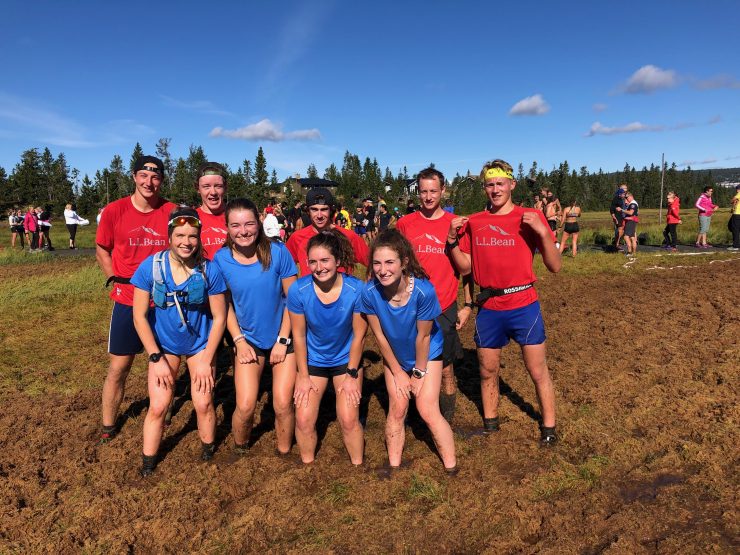
“And my angle on that,” Schumacher says, “was that I didn’t want to start my NCAA [eligibility] clock – if I take 12 credits, that starts the clock. And if it’s my plan to involve NCAA skiing down the road, I would like to have all of my eligibility. So whether it’s a 26-year-old Norwegian or a 26-year-old American that’s still doing it, I’d like to have that option open.” For now, he notes, “I have the opportunity to get some smaller scholarships that don’t require a full class load.”
Speaking of money, Schumacher also intends to tread very carefully over the next few years when it comes to accepting any potential prize money from SuperTour races or national championships.
“I’m definitely looking to preserve that eligibility,” Schumacher says, explaining that he will look at the NCAA rules very carefully to see what, if anything, he is allowed to accept in terms of prize money.
“I’d definitely double-check that before accepting any prize money,” Schumacher notes. “But the idea is to stay eligible, if I ever wanted to do that.”
Season goals and a return to World Juniors
So let’s go back to last year’s World Juniors men’s relay for a second, featuring a relay lineup that underscored the fact that American junior cross-country skiing is fundamentally a very small world, as well as that 3-kilometer Anchorage middle school competitions are truly a breeding ground for future champions.
Luke Jager, an Anchorage skier who had told this site that he prepared for the race by “reminiscing about beating Gus Schumacher at the season opener middle school race in 8th grade” in February 2014, skis the scramble leg, keeping the Americans in sixth as a number of teams already start to drop off the pace. Ben Ogden, a Vermont skier of whom Jager and Schumacher once wrote, “We were so impressed that @ben.0gden could beat any of us that we decided to make him an honorary Alaskan,” brings the team up to fourth by the end of leg two. Hunter Wonders, an Anchorage skier who finished 1.7 seconds behind Jager in the sixth-grade season opener middle school race in January 2012, holds that position through leg three, handing off to Schumacher 31.3 seconds out of first and 26.2 seconds off the podium.
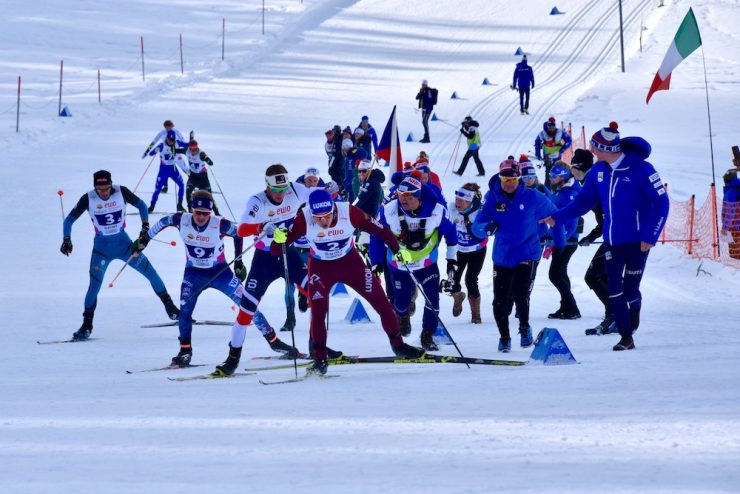
Each leg is only 5 kilometers long, but Schumacher takes off on his anchor leg like a man possessed. He catches France, moving the U.S. onto the podium. He comes around the final corner and suddenly catches sight of Russia and Norway ahead of him. Schumacher surges, Russia’s Alexander Terentev does not, and Schumacher exults across the finish line to secure a historic silver medal for America, 2.2 seconds behind Norway in first. “Second in the world with the boys,” Jager writes on Instagram. “Doesn’t get much better.”
“There was definitely a good amount of surprise there,” Schumacher candidly says of the result. “I remember pretty distinctly the night before, in the pre-race meeting, Hunter saying something about, ‘If the stars align, we could podium.’ … We definitely didn’t write ourselves off, but we also weren’t thinking we had a guaranteed spot anywhere.”
But once the race began, Schumacher recalls, “Every lap it got more and more exciting. Like, ‘Oh, cool, Luke’s hanging with the lead pack.’ And then, like, ‘Oh, lots of people got dropped from the lead pack, and Luke’s still there. Oh, the lead pack is down to five, and Ben’s still there. And then Hunter’s hanging on, and not losing time.’ It was really cool and exciting – and you could tell the excitement of everyone there, like the coaches are like, ‘you ready, Gus’; they can see what’s happening, and we can all see what’s happening. It was a pretty fun event to be a part of.”
When Schumacher spoke with FasterSkier in late December, before U.S. nationals, he said with an absolutely straight face that he just hoped to qualify for this year’s team.
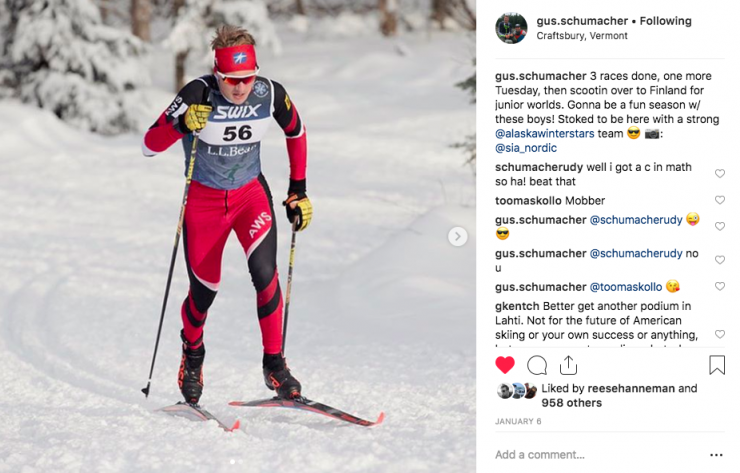
Then he notched a perfect score in the U.S. nationals qualifying races, so that worked out. He’s in Lahti now, with the rest of the American team.
When asked about a results goal for this season, Schumacher immediately zeroes in on this event: “My biggest goal is to improve on our relay result from last year at World Juniors, and win that race. I think that would be super crazy, and super fun. I think that this, or next year too, is the year to do it; there’s such a strong group of guys that has a lot of chemistry. I think that – if we did that, I could sign off on the season from there. That would be pretty amazing.”
(It’s worth noting that the U.S. had by far the youngest relay team of the top-10 teams at last year’s World Juniors; while Norway et al. will obviously refill their ranks from within, Schumacher really could have two more cracks at this race.)
After World Juniors, which occur in Lahti, Finland, from January 20-27, Schumacher hopes to stay in Europe for some time. “There’s a possibility that I would stay, maybe in Norway with a friend, or somewhere over in Europe, and continue some high-level races, possibly with Luke, and then maybe the OPA Cup trip, and SuperTour Finals after that. All of it obviously sort of depends on how I’m doing, and how I’m feeling and stuff. But ideally I spend a good amount of time in Europe, getting some race exposure, and getting some success, and competitive races there, and just kind of keep my season going after Nationals.”
Looking to the future
Schumacher is asked what the American success in Goms last year says about the current strength of American men’s skiing.
His answer reflects an athlete who recognizes a cliché when he sees it, but who nonetheless sincerely believes in the strength of the team: “I think you don’t have to look super deep into it to notice that there’s a strong group of guys that are coming up. And it extends way past that relay team. I think it’s, maybe not cliché yet, but it’s said a lot, that, like, there’s a team behind the team. And I think one of the big things to say about the future is that there were four guys in bibs that day, but – this is going to sound pretty cliché – but there were twenty that got us there. You see other athletes, like Johnny Hagenbuch, that have the potential – I could list off ten people that could be on that relay team this year. Like, I might not even part of that. There’s so many fast boys that are really into it; I think there’s some promise there.”
Finally, a similar theme emerges when the topic turns to the future of American men’s skiing over the next generation: Be a successful team, just like the American women.
I would like, everyone would like, us to be like the girls – they’re really good.
“Obviously I don’t know” what the future holds, Schumacher says, “but a pretty strong upwards trajectory is what I would say. I think the goal obviously, sort of unspoken, but I would like to see us get to where the girls are. They have a ton of success, and to try to mimic that, and do what they’ve been doing – everyone talks about the team, and I think that for this whole generation, not just like this year’s juniors, but even the older ones as well, there’s that sense of team. I would like, everyone would like, us to be like the girls – they’re really good. I think it’s possible. It would be really cool, and I think it’s doable.”
Gavin Kentch
Gavin Kentch wrote for FasterSkier from 2016–2022. He has a cat named Marit.


